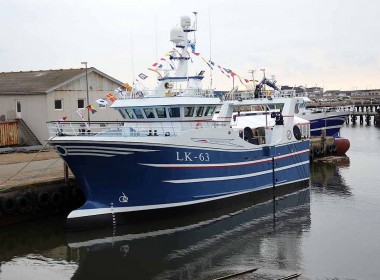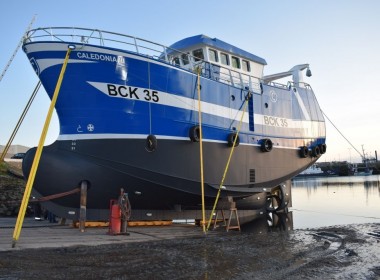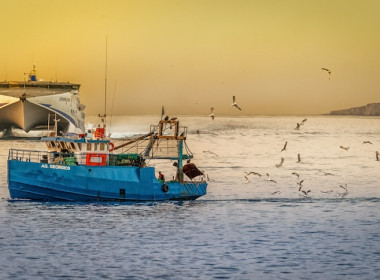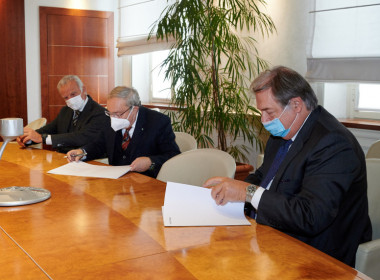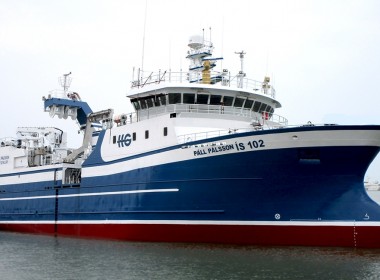REMINISCENCES | Frank Goto and the United Fishing Agency

The United Fishing Agency is one of the best things that has ever happened to Hawaii’s seafood industry. It is also one of the best things that ever happened to me.
Without doubt it completed my education in ichthyology and marine biology. Not only that, it was indirectly responsible insert for me being posted to the US Embassy in Tokyo as Regional Fisheries Attaché.
Going to the agency’s fresh fish auction for me was like going to a graduate seminar in marine biology and fisheries. The auction floor of the agency was my final Professor of Fisheries and Marine Biology. As a result, I have a very warm feeling in my heart for the United Fishing Agency.
The agency not only revolutionised and changed for the better the way Hawaii’s seafood is marketed, but it resulted in a “fishing village” of related businesses being created in the area of Piers 36 and 38. This included dock space for the dozens of Hawaii-based longliners fishing for tuna, marlin, and other pelagic species, Pacific Ocean Producers, a huge marine and fisheries hardware store established in 1983 by Sean Martin, owner of the longliner Finback, and ex-akule aerial spotter Jim Cook, owner of the longliner Kaimi. It houses a mammoth ice maker that serves fishing vessels as well as other customers island wide, several restaurants, and even a government office (NOAA Fisheries).
Catches of moonfish and monchong (pomfrets) caught by Hawaii’s small longline fleet, mahimahi caught trolling, and aku from the live bait pole-and-line boats are put on the auction floor and iced. Other catches arrived as tubs of akule caught by Leo Ohai (dean of Hawaii’s akule fishery), an occasional tub of lobsters, and individual snappers such as opakapaka, gindai, uku, onaga, and kalikali caught by deep-water handline fishermen.
Besides the pelagic species offered for sale, there were the shallow-water goatfishes (weke and kumu), the occasional ulua caught by recreational fishermen, and many other reef fish.
One fish that caught my eye was the kahala (amberjack) a large deep-water snapper with a diagonal dark stripe running downwards from the top of its head to about eye level. Kahala is species that is no longer sold at the auction due to Department of Health advisories (more on this later). All fish now sold at the auction are caught by hook and line.
Brooks Takenaka, the auction’s general manager, is fond of saying that Hawaii’s pelagic longline fishery is the world’s best managed, pointing out that 20 per cent of Hawaii’s tuna longliners carry federal observers and that 100 per cent of swordfish longliners carry observers. When their quotas are reached, they stop fishing.
“The auction has become so popular with tourists that guided tours for a limited number of onlookers are offered.”
The United Fishing Agency is a privately-held company with Mr Akira Otani as President, Brooks Takenaka as Manager, and Frank Goto as General Manager Emeritus. I had the pleasure of meeting Akira Otani for the first time in 1979 when the auction moved to Pier 13.
Mr Otani had an office adjacent to the auction and he would let me visit with him several mornings a week to talk marine fisheries and what the National Marine Fisheries Service was doing that could affect commercial fishing. A finer Japanese gentleman than Mr Otani I have never met.
Every time the auction moved – from Nimitz Highway to Pier 13 and to Pier 38 – it adopted and used the environmentally best methods of processing the catches. Tuna, billfishes, and other species are packed in ice at sea. When they tie up at Pier 38, they start unloading their catches starting at about 1 a.m.
The fish are immediately taken to the auction floor, where they are arranged in rows and again packed with ice on top of and between the fish. In years when the auction was on Nimitz Highway and at Pier 13, a small flap of flesh was cut near the tuna’s tail fin. In order to determine the fatness of the tuna, the buyer would stick their fingers inside the fish, grab a little flesh and then rub the flesh between their fingers to check on the fatness.
Now, instead of grabbing some flesh by finger nicking, the fat content can be determined by looking at a core about four inches long laid on the body of the tuna for inspection. A larger chunk of flesh from the tail area is often cut out for visual inspection.
The weight of each fish, the boat it came from, and its buyer and selling price are placed on white pieces of paper that are stuck to the fishes’ bodies. All this information using bar codes and other software is transmitted electronically to the office so that bank checks with the price of the fish sold can be issued to the responsible longliner the same day the fish are sold. The auction withholds 10 per cent for its services in processing the fish.
According to Brooks Takenaka, daily sales can be as high as 160,000 pounds and yearly sales between 25 million and 28 million pounds, which is about three per cent of all Pacific marine catches. Because the auction is a privately held company, its financial details are not available. However, it does have 60 employees.
The auction has become so popular with tourists that guided tours for a limited number of onlookers are offered on Saturday mornings by Dr John Kaneko, Program Manager of the Hawaii Seafood Council. There is a small fee (US$25) that is well worth the lecture. Dr Kaneko does a great job in explaining how the auction works. I know because I took the tour in 2015.
“I really liked this job for it gave me the opportunity to go out on research cruises.”
My entrance to the world of Pacific fisheries and marine biology did not follow the usual educational path – I have only a bachelor’s degree in liberal arts from Georgetown University (1950), so I am going to digress a bit on how my fisheries career got started and then return to how it improved as a result of my association with the agency.
In 1952, I was 25 years old and working as a news writer at the Hawaii Visitors Bureau. I had just gotten out of the US Navy in Hawaii where I was a Journalist, Third Class and running a small navy newspaper for the officers and men of the headquarters of the 14th Naval District, which is in Pearl Harbor.
In my spare time, I took up snorkelling and scuba diving to watch the behaviour of Hawaii’s reef fishes, the occasional ulua, and a shark or two. I was really hooked on marine biology and in 1954, I sought advice from Vernon Brock, Director of the Hawaii Department of Fish and Game, and Dr Robert Hiatt, Chairman of the Department of Zoology at the University of Hawaii, on how a mature age student with zero background in science might become an ichthyologist and marine biologist.
They told me that if I worked hard and doubled up on some courses (that is, taking both introductory and advanced courses at the same time) I might be able to pull it off. And I did through the mentoring of graduate advisor Phil Helfrich (now Dr Phil Helfrich, Director Emeritus of the University of the Hawaii Institute of Marine Biology) in Kaneohe Bay. I progressed slowly on the academic front getting mostly Bs and B pluses in my course work – but straight As in ichthyology, which was taught by Dr Bill Gosline.
My office was located right next to that of Dr Jack Randall – the world’s expert on the taxonomy of tropical marine and reef fishes – with over 700 papers and books published on this subject. Jack Randall recognised I was a keen student of ichthyology and urged me not to falter. But after a couple of years I was running out of money and could not continue to be a graduate student.
In 1955, I was offered a job as an entry level fishery technician at the then US Pacific Oceanic Fisheries Investigation (now National Marine Fisheries Service) on Dole Street in Honolulu. So, I left academia for a job as a “plankton picker”.
In the laboratory plankton pickers, take the unanalysed plankton animals caught by nets at sea and flushed into quart jars of formaldehyde, then divided into equal aliquots and through a mathematical formula, they determine the biomass of plankton per cubic meter of water strained by the plankton nets towed by the research vessels Hugh M. Smith, John R. Manning, and Charles H. Gilbert.
A year later, I was promoted to the laboratory position of curator of fishes and invertebrates. I really liked this job for it gave me the opportunity to go out on research cruises and help deploy and haul back the plankton nets and midwater trawls.
My job as curator of fishes left me with some spare time on my hands, so I decided to snoop around the fisheries waterfront, both where the live bait aku boats unloaded their catches into the Hawaiian Tuna Packers cannery, and find out where the tuna longliners fished and how and where the deep sea hook and line fishing boats plied their skills. I got to know aku boat skippers such as Tom Fukunaga of Kula Kai, Noburo Tsue of Buccaneer, and the colorful Richard Kinney, an occasional skipper of several aku boats.
One day I was poking around the fresh fish stalls on North King Street in downtown Honolulu and discovered a small fresh fish market that fronted on Nimitz Highway opposite Pier 15. I asked someone the name of this small market and was told it was the United Fishing Agency and run by a Mr Frank Goto.
After a while, I introduced myself as a fishery technician to Mr Goto and asked him if I could watch what was going on. He said yes and as I looked at all the fish, I realised I had a lot to learn about pelagic species. I would ask Mr Goto a question or two, which he always politely answered.
“I don’t remember when it became known that eating kahala, especially the liver, can result in ciguatera poisoning.”
I have a distinct memory of one day when Frank Goto was man handling several wooden skips around the auction floor and seemed to be having trouble positioning them for some incoming tuna. So, without being asked, I grabbed some of the skips and put them where he wanted them. He did not say anything but probably wondered, “Who is this guy grabbing my skips?”
I later spent many a morning watching the United Fishing Agency in action on Nimitz Highway. These are the facts that eventually led me to my association with the agency, and with Frank Goto, who was the force in establishing the auction on Nimitz Highway, which later moved to Pier 13 on Ahui Street in 1979, and then to Pier 38 in 2004. There are a lot of published news articles about how it took the agency 25 years to overcome the bureaucracy and environmental problems (with the soil) in order to move from Pier 13 to Pier 38.
Whilst I learned a lot from observing the auction on Nimitz Highway, my ichthyological education really took off when it moved to Pier 13. Operations expanded and more fish were on the floor. Here are some examples.
Once I was trying to determine the species of a tuna with somewhat darkened colours and no pectoral fins. I thought it might be an albacore, but without the pectorals, I could not be certain. Somebody, probably Brooks Takenaka, who was then running operations on the floor said, “Bob, it’s easy to spot an albacore. All you need is the caudal (tail) fin and look for the white trim on its trailing edge – a strip of white about three-eighths of an inch wide.” And he was right.
On another occasion, some kahala (amberjack) were being auctioned and I could sense there was something a bit odd about what was going on. The weight of the fish was under discussion. “Was its weight less than 25 lbs?”
I don’t remember when it became known that eating kahala, especially the liver, can result in ciguatera poisoning and that kahala should not be eaten if they weighed more than 25 lbs. My understanding is that kahala are no longer sold through the auction thus there is no problem with ciguatera poisoning. But if a deep-sea fisherman catches a kahala over 25 pounds and eats it there is still the possibility of coming down with ciguatera.
Another fish you must be careful about eating is the walu (oil fish), which occurs down to at least to 1,000 feet and are caught mainly by deep sea handline fishermen and occasionally by tuna longliners, as the walu is island associated. Its flesh is very oily and can have a purgative effect if too much is eaten. Short bony tubercles are interspaced with regular scales, so if you rub the fish the wrong way, these tubercules will cut into your skin. I learned about oil fish from an old Hawaii fisheries hand, Buzzy Agard, who told me that he had once eaten too much walu with the negative result following.
There is a second species of oil fish that is also found on the auction floor. This one has smooth skin, but I don’t know if its flesh also causes diarrhoea.
“The reason there was no radiation contamination in the ahi is because the winds carried the bomb’s radioactive debris southwest towards the Marshall Islands.”
Frank Goto’s activities in seafood marketing went far beyond the auction. For example, in 1976, the US Congress passed the Fisheries Management and Conservation Act and established and a 200-mile Fishery Conservation Zone (later changed to Exclusive Economic Zone) in waters three to 200 nautical miles offshore. They included waters around the State of Hawaii, eight Pacific Remote Island Areas (PRIAs), and Guam.
The PRIAs are Wake Island, Johnston Atoll, Howland Island, Baker Island, Kingman Reef, Jarvis Island, Palmyra Atoll, and Midway Islands. The EEZ eventually included waters around the Commonwealth of the Northern Marianas Islands after it concluded an association with the US.
The Western Pacific Regional Fishery Management Council (WPRFMC) was created with the charge to manage fisheries in the FCZ. One of the first appointed voting members of the Council was Frank Goto. I was appointed as Acting Executive Director until a full-time Executive Director (Wilvan Van Campen) was employed. My job was to get the council up and running, which I did.
What follows is from an unpublished history of the WPRFMC that describes Frank Goto’s background in establishing the United Fishing Agency.
“When council member Frank Goto was a young man working on the Honolulu waterfront, workers at the fish auction formed a small clannish group. Every morning in those days during the 1950s, the men of the Honolulu fish auction would get up early to unload the sampans and lay out what seemed to be an endless stream of aku on the clean wet concrete floor of the auction house. It was a small, tight-knit group bonded by the fact that many were second and third generation fishermen from Wakayama, Japan. They had established, after many years of fishing, business relationships with Native Hawaiians, Chinese, and Portuguese in Hawaii as well as links with the Portuguese, Italian, and Norwegian fishing businesses of the West Coast.
“The workers on the waterfront tended to follow a code. The work was hard. The fish were maintained at very high quality and a person’s word was his or her bond. Business relationships were often based on a handshake. Mutual trust and customer loyalty were a given. When Frank Goto thought about the work that he did for the United Fishing Agency, which operated the fish auction in Honolulu, bringing the large silver tuna into the fish auction, where the buyers for the local markets and restaurants would inspect them by making small incisions in their tails to test the firmness and freshness,” he was proud.
“‘I felt good about what I was doing,’ Goto recalls. ‘There were hungry people in the world, and I was feeding them.’
Frank Goto was a very effective Council member because I had previously watched him ask tough questions at pre-cruise meetings at the Honolulu Laboratory of the National Marine Fisheries Service – when Jack Marr was the laboratory’s director.
I have a recollection of him wanting details of a tuna longlining cruise in 1962 by the research vessel Charles H. Gilbert to Christmas Island, about 1,200 miles south of Honolulu. Gilbert had been chartered by the US Atomic Energy Commission, and when a US Air Force bomber released an atomic bomb to explode in the air, Gilbert was to go longlining under where the bomb exploded but 24 hours after the explosion, which we did and made a good catch of ahi.
Frank wanted to know what we would do with the ahi caught under where the bomb burst. Jack Marr assured Frank the ahi would all be tested for radiation and no fish with radiation would be brought back to Hawaii to be eaten. I was the Field Party Chief on that Gilbert cruise, so I kept every single scrap of paper about the cruise for future reference – and which I still have – so I know about the radiation results of the ahi we caught longlining under the site of the explosion.
So, what happened to the ahi we caught under the bomb’s fallout? We ate them. There was absolutely no radiation contaminating the ahi.
Dr Ralph Palumbo of the University of Washington and Dr Roy Nakatani of the General Electric Company measured every single ahi and found no radioactive contamination, but they did find some atomic residues from Russian and United States atomic testing years before. The reason there was no radiation contamination in the ahi is because the winds carried the bomb’s radioactive debris southwest towards the Marshall Islands. It is said that the Marshall Island’s President Amata Kabua was very angry about this.
An unusual and best part of the Gilbert cruise was still to come.
Before leaving Honolulu, I bet lab director Jack Marr a case of beer our longlining would result in the highest percentage of ahi ever caught by a lab research vessel.
So about 50 miles north of Christmas Island, we put out a longline with only 360 hooks. What comes next sounds as if it is a made-up story, but it is true!
From those 360 hooks we caught and landed 78 yellowfin tuna all weighing over 100 pounds. That is a 22 per cent catch rate. Commercial longliners say catch rates of two or three per cent are very good. We butchered every single one and refrigerated them for the trip home.
Jack Marr was waiting for us on the dock at Kewalo Basin with a case of beer under his arm. I don’t know what Frank Goto may have said after he found out about our catch of ahi – as he can be a tough man to impress – but I think we all got a pat on the back for that bit of work.
One final comment. On December 17, 2015, Frank Goto was recognised by NOAA Fisheries for his “leadership and many contributions to the commercial fishing and seafood industries in Hawaii and the Pacific Islands Region.” Samuel Rauch, Assistant Administrator for NOAA Fisheries, presented Mr Goto with a plaque that will hang at the NOAA Fisheries Honolulu Service Center at Pier 38.
At the opening of the Service Center in 2010, US Senator Daniel Inouye said that Frank Goto was the driving force behind the establishment of the Honolulu Service Center and said that Mr Goto should be acknowledged for his efforts.
Well done, Frank Goto!
The above article is an excerpt from Swimming with Fishes, Dr Bob Iversen’s memoir detailing his experiences as a fishery biologist. It is reposted here on Baird Maritime with the author’s permission.
Submissions wanted! Do you have an exciting, amusing, or downright dangerous anecdote from your time in the maritime world? Send your submissions to: [email protected].


